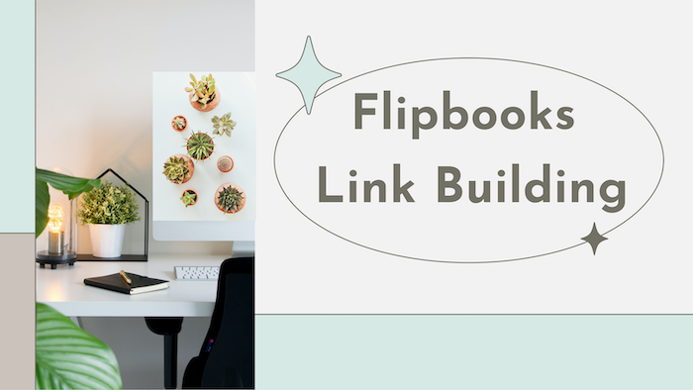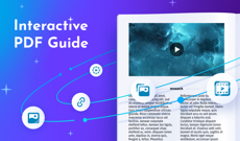If you’ve been creating flipbooks with FlippingBook for quite some time, you’re already familiar with their distinctive features, such as realistic page flip effect, clean modern design, and interactivity. But there’s much more to flipbooks! They don’t just look fresh and professional, but the flipbook format also uses state-of-the-art technology to achieve the best results with your content promotion.
That’s why a flipbook is an ideal means for a link building campaign. And link building is one of the most effective ways to rank high on Google, increase views on new content, and grow your audience. In our article, we’ll cover the most efficient ways of using flipbooks for link building but first, we’ll give you a quick rundown of the basic rules for creating an SEO-friendly flipbook.
Before You Get Started: Enhance Your Flipbook for SEO
- When creating a PDF that you’ll convert into a flipbook later on, don’t forget to add informative headings and relevant keywords across the pages. They will make your content very convenient to read for people and easy to index for search engines. We have an article with many useful tips on optimizing your PDFs for SEO, check it out as well.
- Add relevant and informative title and description. These tags help the readers and search engines understand what your content is about and index it accordingly for relevant keywords. Thus, you make sure that your flipbook is well optimized for both search engines and visitors. At FlippingBook, we’ve carried out our own experiment on how to promote flipbooks efficiently and wrote an article about it, you can read it to learn about the tips and tricks we’ve come up with.
- Enhance your flipbook with interactivity. When you start building links with your flipbooks, the first impression plays a big role for the new audience that doesn’t know anything about you yet. By adding enticing videos, compelling pop-up images, or funny GIFs you make your content much more engaging, thus people are more likely to read it in depth, which is great for SEO. It also sets the stage for the natural generation of editorial links, given how compelling and unique your content becomes.

And now, when you’ve successfully enhanced your content for SEO, you can start the link building activities. Below, you’ll find the top link building strategies you can use right away. And they’re all free! You only pay for your FlippingBook subscription and build links free of charge. Let’s get right to it.
#1 Social Media
Social media can give your link building campaign a great head start. Whether you’re an individual or a company, you most certainly have profiles in several social networks. So use them to your advantage and don’t forget to post every flipbook you want to promote on social media. Write a captivating caption to invite your clients to open a flipbook and its neat and engaging preview will work for itself, capturing the readers’ attention at once. Here are the main channels you could use.

LinkedIn is a professional network that allows people to connect, find new jobs, and share the latest industry insights. You can benefit from this network by sharing flipbooks related to your business, for example, your expert advice, knowledge, and tips and tricks on how to make your industry even more successful. Plus, make use of LinkedIn groups that have thousands of participants and can drive more traffic to your flipbook. The secret is, really, to share useful and unique information that can help people from your niche.

You can also post a link to your flipbook on your personal or company pages. Facebook is the network for infinite scrolling, longreads, and endless discussions. And all the visuals usually look quite dry and dull there. Flipbooks, on the contrary, have a nice and fresh preview when posted to Facebook. Seeing your flipbook on the feed will make people stop scrolling and click the link to learn what it’s all about. It's a great way to receive Facebook leads through valuable content. That’s why some consider flipbooks to be the best option for posting content on Facebook.

Twitter can be an amazing way for driving more attention to your flipbook link and getting more reposts, shares, and comments. Plus, posting your flipbook on Twitter helps you overcome the 280 characters' limit, simply write a catchy opening phrase and invite readers to learn more in the flipbook. You can also create an engaging or very informative thread, introducing your flipbook, or think of some funny story to share with your readers. Just be human and genuine. Maybe your tweet will even go viral, who knows?
#2 QA Platforms
QA platforms such as Quora and Reddit are also excellent for building links with your flipbooks. People always search for answers, so giving them the valuable knowledge they need will help promote your flipbooks to a much wider audience. It takes a bit more time and effort than social networks, but it’s totally worth a try.
Quora
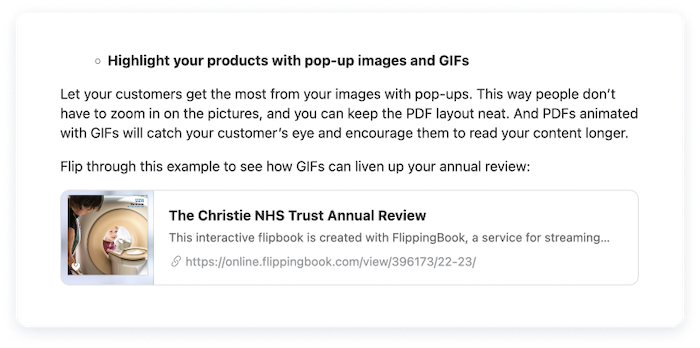
Quora is the essence of all QA platforms because it’s made specifically for people asking their own questions and answering those of others. You can act as an individual or create a whole space for your company. We've created a FlippingBook space on Quora as well, so come say hi and follow us for different tips and tricks on creating flipbooks! The website has different categories—choose the ones where you can give an insightful response. And then add a link to your flipbook related to the answer you’ve posted and write a thorough, human answer to the question. If people appreciate your answers, they will likely share them on their pages or other resources. Don’t post similar, repetitive answers as this will show your profile as unreliable and violate the platform’s rules.
Reddit, another QA platform, can seem difficult for new users because the site is quite complex. Registered members can submit content to the site, which is then voted up or down by other members. Posts are organized by subject into user-created boards called subreddits. Reddit allows you to add images and links to your answers but you have to be careful with that—only highly relevant links will be clicked. Irrelevant answers will be downvoted and marked as spam. However, if you receive positive votes for your answer, your post will become more significant and will bring people to your flipbook and website.
#3 Medium
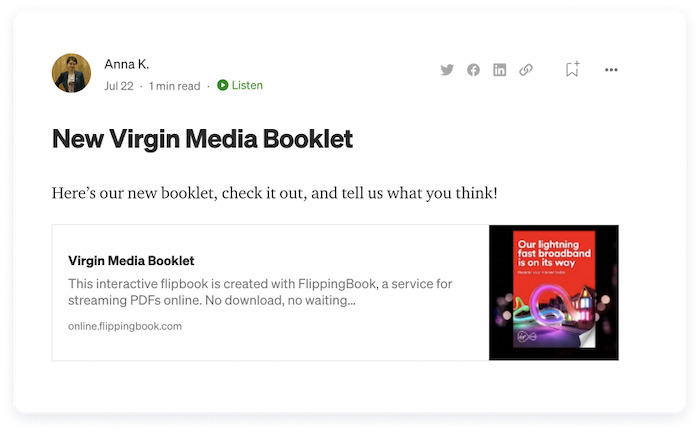
Medium is a platform where you can publish your content as an individual contributor or as a company. You can either create standalone articles there and include flipbooks as examples or run something similar to a blog on your site. The platform has thousands of readers every day and a good SEO rating, so your content will be seen by a lot of people.
#4 Website
Your own website is a great place to share your flipbooks. You can embed fresh flipbooks on the main page so that people learn about what’s new right away. Plus, you can create a specific page with resources: brochures, ebooks, whitepapers, or whatever content you publish. It will allow you to get more clients to read your flipbooks and it will be very convenient for readers to have everything they need in one place.
Your embedded flipbook will look just like this one:
#5 WordPress
WordPress is one of the most popular platforms for building a website, so if you have a WordPress website, you can embed your flipbook there. At FlippingBook, we have created a WordPress plugin to make the embedding process easy and smooth. Adding flipbooks, catalogs, brochures, or magazines to the pages of your website will give such online documents additional backlinks. And your visitors will be able to read tons of useful information on your website without going anywhere.
#6 Pinterest
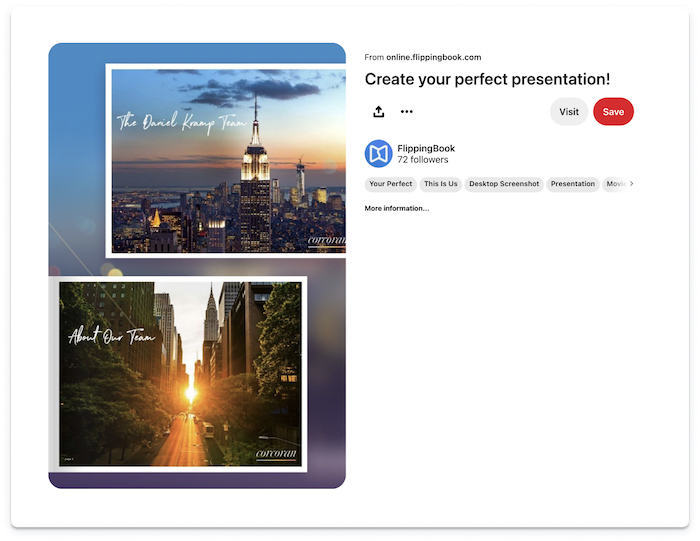
If your flipbooks have a bright and artistic look, you can design an enticing image preview, upload it to Pinterest with relevant hashtags, and link it to your flipbook. Don’t forget to add your company branding to the flipbook and to the images as well to raise your brand awareness. Pinterest has a high domain rating, a unique feed algorithm, and a big audience, so a link on this website will be valuable for search engines and will drive new traffic to your flipbook.
#7 Advanced Link Building Options
There are also many more advanced ways to build links with flipbooks, so if you have link building and SEO specialists in your company, you can improve your internal SEO training and add these methods to your strategy.
Guest posting
You can start with creating a number of guest posts and pitch them to other sites that are relevant to your niche. Usually, you can include links in the content to the key pages on your site. Why not add a link to your flipbook? Maybe even with a compelling preview. Such backlinks help increase your brand awareness and popularity faster.
Classical link building
You can start by shortlisting sites that would be appropriate for your flipbook and then reach out to them to offer a link building partnership. Don’t forget to mention that you offer a link to your flipbook, not a website. Many marketers are open to trying fresh approaches and will be glad to collaborate with you.
Go Ahead and Start Building Links with Your Flipbooks
These were the most popular and easy ways to build links with your flipbooks. If you use these methods, they can already give your new content a significant boost. The rule ‘the more backlinks, the more traffic’ really works, we’ve tried it ourselves and keep building links every day. So don’t hesitate to try and refine and update your link building strategy on the go. Good luck!

